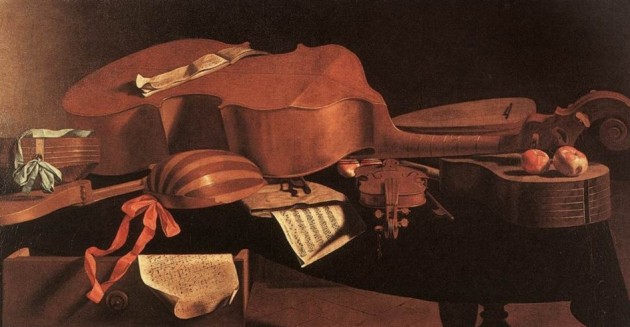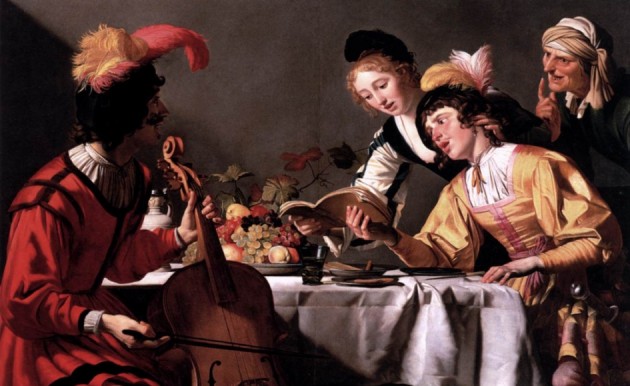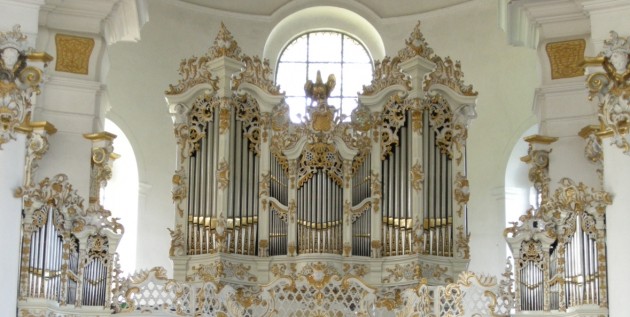Bach in Black
“You maligned my bassoon!” – 18th century music student, shortly before assaulting Bach (this is a true story, look it up).
With a thousand works to choose from, it can be difficult to know where to start. In fact, it’s often easier to identify Bach’s works by number than name. A good place to begin is with the Brandenburg Concertos, probably his most accessible pieces. They gained their nickname because the aristocrat they were written for lived in the region of Brandenburg. Sadly, he never actually listened to them, but because of his simple Protestant tastes, he inadvertently ensured their huge popularity today. Hopefully by now you know roughly what a concerto is, but the Brandenburgs put a slight twist on the genre by giving solos to several different instruments in each piece. It doesn’t sound particularly interesting on paper, but the effect is impressive when you hear it. All six are brilliant, and because this is the Baroque, they’re also wonderfully concise. I’ve left these videos visible so you can get a general feeling for the music of the period, its structure, and the more historically accurate way it’s performed today. In the first video, watch out for the insane harpsichord solo which starts six minutes in, and in the last, listen out for the frantic viola duel:
Brandenburg Concerto No. 5 in D Major, BWV 1050 – 1st Movement, Allegro:
Brandenburg Concerto No. 4 in G Major, BWV 1049 – 1st Movement, Allegro:
Brandenburg Concerto No. 3 in G Major, BWV 1048 – 1st Movement, Allegro:
Brandenburg Concerto No. 6 in Bb Major, BWV 1051 – 3rd Movement, Allegro:
Bach’s other concertos are also fantastic, but they’re also slightly confusing. Many of the original scores have been lost, with parts reconstructed from transcriptions for other instruments. As a result, you can end up hearing what is basically the same piece being played on a violin, a harpsichord, or an oboe – and sometimes all three at once. What this means is that we have the choice, as listeners, to select whichever arrangement of a concerto we prefer. Here are a few of the best bits, with the instrumentation that I think works best:
Violin Concerto in E Major, BWV 1042 – 1st Movement, Allegro
Harpsichord Concerto in D Minor, BWV 1052 – 1st Movement, Allegro
Oboe Concerto in A Major, BWV 1055 – 3rd Movement, Allegro
If you prefer something a little calmer, the double concertos both have exceptionally beautiful slow movements:
Double Violin Concerto in D Minor, BWV 1043 – 2nd Movement, Largo
Double concerto for Oboe and Violin in C Minor, BWV 1060 – 2nd Movement, Adagio
Suite Dreams
If you enjoyed the concertos, it’s well worth investigating Bach’s orchestral suites. Here are two extracts you probably already recognise to get you started:
Orchestral Suite No. 3, BWV 1068 – 2nd Movement – Aria (“Air on the G String”)
Orchestral Suite No. 2, BWV 1067, 7th Movement – Badinerie
Where are Bach’s symphonies? Well, he didn’t write any, for the simple reason that they hadn’t been invented yet, although his son Johann Christian would later help develop the form. What Bach did write, though, was a huge amount of solo instrumental music. These works are often grouped under a lot of different titles like partitas and sonatas, but they all more or less follow a single format – the suite. In a suite, there are usually about six sections, each of which uses a different kind of dance as a basic musical template. There were many different kinds of dance which came from all over Europe, but the only thing you really need to keep in mind is that each uses a different rhythm, from slow sarabandes to lively gigues. The six solo cello suites are amongst the most famous and popular of all his works, and are a great place to start exploring his more intimate instrumental pieces. Like many of the other suites, they gradually become more complex as you move through them, starting with the simplicity of the first suite (which you may already know from Master & Commander) and eventually reaching the richly layered and ornamented sixth suite. Here are some highlights:
Cello Suite No.1 in G Major, BWV 1007 – 1st Movement, Prelude
Cello Suite No. 3 in C Major, BWV 1009 – 6th Movement, Gigue
Cello Suite No. 4 in Eb Major, BWV 1010 – 5th Movement, Bourée
Cello Suite No. 6 in D Major, BWV 1012 – 5th Movement, Gavotte
Cello Suite No. 2 in D Minor, BWV 1008 – 4th Movement, Sarabande
The cello suites have become popular because they were rediscovered relatively recently, but a number of Bach’s other instrumental suites are just as accomplished. The sonatas and partitas for solo violin are especially good, particularly the famous Chaconne, which showcases every technique available to a violinist, and which some musicologists believe may have been written as an expression of Bach’s grief after the death of his first wife. There are also suites for lute, flute, and harpsichord. These extracts should give you a flavour of the suites – you can explore the rest for yourself:
Violin Partita No. 2 in D Minor, BWV 1004 – 5th Movement, Chaconne
Violin Partita No. 1 in B Minor, BWV 1002 – 4th Movement, Double presto
Violin Partita No. 3 in E Major, BWV 1006 – 1st Movement, Prelude
French Suite for Harpsichord No. 5 in G Major, BWV 816 – 7th Movement, Gigue
English Suite for Harpsichord No. 2 in A Minor, BWV 807 – 7th Movement, Gigue
Keyboard Partita No. 3 in A Minor, BWV 827 – 7th Movement, Gigue
Flute Partita in A Minor, BWV 1013 – 1st Movement, Allemande
Lute Suite No. 3 in C Minor, BWV 997 – 4th Movement, Gigue double
My Bach Pages
Next we come to the Bach works I like best, and where his style seems most fitting – his organ music. Bach was one of Europe’s leading experts on the organ, so when he wasn’t playing them, he was advising people about how to repair them. The organ is unbelievably difficult to play, as it requires not only both hands playing several layers of keys, but both feet as well, operating the deep bass sounds of the pedals below. Bach even wrote a little pedal exercise to get his feet warmed up:
Pedalexercitium, BWV 598
A musical form which Bach used very frequently in his organ works was something called a fugue. There is no simple way to explain what a fugue is. You can look it up if you really want, but it’ll probably just leave you even more confused. Listening In to other a words fugue it is can like be trying completely to baffling read if two you sentences don’t at concentrate the and same pay time attention. With practice however, you can learn to spot a fugue, because the basic texture is readily recognisable. Fugues are often preceded by Toccatas, which are sections designed to be difficult to get your fingers round – it comes from the Italian toccare, “to touch.” While all this might sound a bit obscure, it’s probably more familiar than you realise:
Toccata and Fugue in D Minor, BWV 565
The irony is, however, that despite being Bach’s most famous piece, it’s likely that he didn’t actually write it. There’s no surviving copy of the work in the composer’s own handwriting, and it uses a lot of musical devices that don’t appear anywhere else in his, or anyone else’s work, during the Baroque period. Some have suggested that it was a loving tribute to Bach written by an anonymous fan at a later date. But it’s still a great piece of music, so who really cares? If you watched the video carefully you may also have noticed that the organist and his assistant kept changing the tone by adjusting the little wooden handles on either side. These are the organ stops, hence the expression “pulling out all the stops.” The stops control which of the several thousand organ pipes are used at any given time. This allows the organist to produce a wide range of sounds, pitches and timbres, and even imitate other instruments, including the human voice. You can do so many things simultaneously with an organ, that you can actually make a single instrument sound like chamber music. The organ was a Minimoog, a Roland TR-808 and a vocoder all rolled into one. And if you think that comparison seems a bit forced, you’re wrong.
Predictably enough, Bach wrote quite a few pieces for the organ. Here are some of the better-known ones, starting with the Passacaglia and Fugue in C Minor, in which Bach takes a seemingly simple bass line and gradually builds more and more ornamentation onto it. The Toccata, Adagio and Fugue is a particular favourite of mine – watch out for the amazing transition at around 1:55, and the Dorian Toccata and Fugue beats Miles Davis by several hundred years in its use of unusual modality.
Passacaglia and Fugue in C minor, BWV 582
“Little” Fugue in G Minor, BWV 578
Toccata, Adagio and Fugue in C major, BWV 564
Fantasia in G Major “Pièce d’Orgue”, BWV 572
Fantasia and Fugue in G Minor “Great”, BWV 542
Toccata and Fugue in D Minor “Dorian”, BWV 538
Prelude and Fugue in A Minor, BWV 543
Prelude and Fugue in D Major, BWV 532
Schubler Chorale No.6, Kommst du nun, Jesu, BWV 650
“Wedge” Fugue in E Minor, BWV 548
Prelude and Fugue in E Minor, BWV 533
Toccata and Fugue in F Major, BWV 540
Organ Arrangement of a Concerto by Vivaldi, BWV 593 – 1st Movement, Allegro
Trio Sonata No. 1 in Eb Major, BWV 525 – 1st Movement, Allegro





